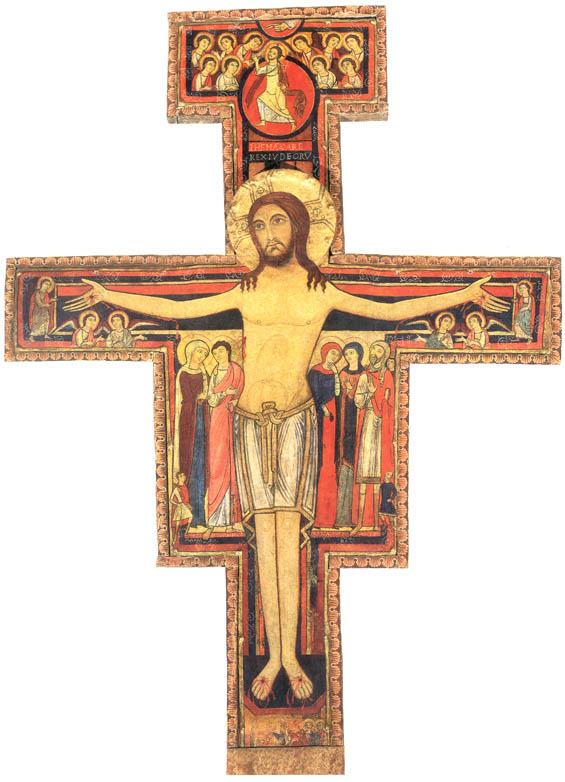 by Theresa Cavicchio
by Theresa CavicchioFor Christians all over the world, meditating on the crucifix takes on an even greater significance during the season of Lent, and particularly so as we approach the holiest days of our Church year. One crucifix which lends itself to reflection on a deeply spiritual level is the one known as the San Damiano Crucifix.
A rustic church located on the outskirts of Assisi, Italy, became the location where the life of a young man – and indeed, the life of the Church – experienced a profound transformation through one life-changing event. At the time, the unimposing church held very little to charm the eye or tempt the faithful to enter; a decrepit, dilapidated structure, it nonetheless housed a true treasure – a large crucifix with a great deal to say.
Probably crafted in the 12th century by a monk whose name is lost to us, the crucifix was painted on carved wood in the Byzantine style of iconography, and so was intended as a tool for teaching. Held captive in its desolate surroundings, it was as if it were waiting there patiently; waiting for the arrival of Francesco Bernardone, son of a wealthy merchant of Assisi.
In 1206 A.D., Francesco (Francis) was a young man in search of a deeper meaning for his life than the free-spirited, life-of-the-party reputation he had earned up to that point. Having returned home from capture and imprisonment after a thwarted attempt at knightly fame, he found himself at a loss as to how to learn the will of God for his life. One thing he knew for sure was that his former ways no longer held any charm for him.
Murray Bodo, OFM, writes of the events at San Damiano on that fateful day in his book entitled Francis: The Journey and the Dream. “Above the altar [Francis] saw the large Byzantine crucifix of Christ. As though driven by an inner force, he fell on his knees and began to pray intensely. ‘Lord Jesus, what do you want me to do?’ … Francis lifted his head from the stone floor and looked searchingly into the eyes of the crucifix … Then as from some faraway place and yet coming surely from the crucifix, a voice clear and resonant pierced Francis’ soul.
‘Francis, go now and repair my church which, as you see, is falling down.’”
Saint Bonaventure’s biography, The Life of St. Francis of Assisi, continues the account: “Then Francis, trembling and full of fear, being in the church alone, wondered at the sound of that marvelous voice and … he fell into a great ecstasy. When he had recovered his senses, and came to himself, he prepared to obey, and set himself at once to fulfill the command which he had received to repair the material church … ”
Francis obeyed, hauling stones to repair the crumbling structure, but soon it became obvious that it was the Catholic Church herself – riddled with corruption on multiple levels at the time – that the Lord intended for Francis to rebuild.
In Francis’ lifetime and beyond, the crucifix which transmitted Jesus’ message contributed greatly toward a much-needed period of renewal from the highest levels of the Church down to the lowliest penitents in the pews.
More than eight hundred years later, the San Damiano Crucifix has still much more to say to us, much more to teach us.
At first glance, it immediately draws the viewer’s eye to the central figure of Jesus, arms extended, side pierced, wounded hands and feet affixed. However, the body of Jesus glows in its glorified state, its crown of thorns now one of glory. Just above the crown, we see the familiar Latin inscription for Jesus of Nazareth, King of the Jews.
Six angels bear witness to the Crucifixion, three at each end of the crossbeam.
The Body of Jesus is flanked on either side by human witnesses to His Crucifixion – on the left, His Mother Mary with John, the beloved disciple; on the right, Mary Magdalene, Mary Clopas, and the centurion who came to believe.
At the bottom of that same central panel stand two smaller figures believed to represent the soldier who wielded the lance through Jesus’ side on the left, and on the right, the soldier who offered Jesus the vinegar-soaked sponge.
Finally, as our eyes travel upward, we see the central figure of the ascended Christ, holding His Cross aloft, surrounded by welcoming angels. And at the very top center, the outstretched right hand of God the Father extends His fingers in blessing.
This crucifix has a great deal more to teach us than the details offered in this overview – the significance of the shells forming its perimeter and the vines encircling the red inside borders of the cross, for example. The closer we look, the more we see; and hopefully, the more we want to learn.
The rich symbolism of the San Damiano Crucifix inspires us to take our place as witnesses to salvation history reaching toward its climax. In this, it fulfills the intention of the ancient iconographer who set his brush to paint so long ago.
The following prayer, attributed to Saint Francis as he heard the voice of Jesus before the Crucifix at San Damiano, provides a fitting conclusion to our reflection. As we meditate upon the image which spoke to the heart of Saint Francis of Assisi, may it be our prayer as well!
Most High, glorious God, enlighten the darkness of my heart and give me true faith, certain hope, and perfect charity, sense and knowledge, Lord, that I may carry out your holy and true command. Amen.
© All Rights Reserved, Living His Life Abundantly®/Women of Grace® http://www.womenofgrace.com